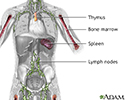Secondary infections
A secondary infection is an infection that occurs during or after treatment for another infection. It may be caused by the first treatment or by changes in the immune system.
Two examples of a secondary infection are:
- Getting a vaginal yeast infection after taking antibiotics to treat an infection caused by bacteria
- Developing pneumonia caused by bacteria after having an upper respiratory infection (like a cold) that was caused by a virus
References
Dorland's Online Medical Dictionary . Available at: www.dorlands.com//def.jsp?id=100053460 . Accessed Sept. 17, 2015.
Reid PT, Innes JA. Respiratory disease. In: Walker BR, Colledge NR, Ralston SH, Penman ID, eds. Davidson's Principles and Practice of Medicine . 22nd ed. Philadelphia, PA: Elsevier; 2014:chap 19.
-
Secondary infection - illustration
Secondary infection occurs during or after treatment of a primary infection because the normal bacterial flora is destroyed, allowing yeast to flourish.
Secondary infection
illustration
-
Immune system structures - illustration
The immune system protects the body from potentially harmful substances. The inflammatory response (inflammation) is part of innate immunity. It occurs when tissues are injured by bacteria, trauma, toxins, heat or any other cause.
Immune system structures
illustration
-
Secondary infection - illustration
Secondary infection occurs during or after treatment of a primary infection because the normal bacterial flora is destroyed, allowing yeast to flourish.
Secondary infection
illustration
-
Immune system structures - illustration
The immune system protects the body from potentially harmful substances. The inflammatory response (inflammation) is part of innate immunity. It occurs when tissues are injured by bacteria, trauma, toxins, heat or any other cause.
Immune system structures
illustration
Review Date: 9/10/2015
Reviewed By: Jatin M. Vyas, MD, PhD, Assistant Professor in Medicine, Harvard Medical School; Assistant in Medicine, Division of Infectious Disease, Department of Medicine, Massachusetts General Hospital, Boston, MA. Also reviewed by David Zieve, MD, MHA, Isla Ogilvie, PhD, and the A.D.A.M. Editorial team.


